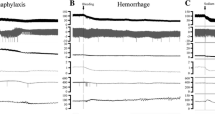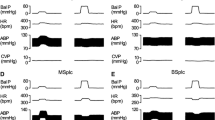Abstract
The pathophysiological changes associated with hypothermia were investigated in the rat stomach under anesthetized conditions. The animal was placed in a styrene foam box and the core body temperature was kept between 24 and 36°C using a heat lamp and refrigerant pack. Lowering of body temperature (<30°C) produced acid hypersecretion and induced hemorrhagic lesions in the gastric mucosa; these responses reached the maximum at 28°C, and a significant relationship was found between acid output and lesion score. Hypothermia (28°C) also caused a marked increase of gastric contractile activity and mucosal blood flow (MBF), but the ratio of acid output to MBF became greater when compared to that obtained under normothermic conditions. These changes induced by hypothermia (28°C) were completely blocked by vagotomy and were significantly inhibited by atropine, hexamethonium, clonidine, or TRH antiserum. However, lowering body temperature did not significantly affect acid secretory, motility, and ulcerogenic responses induced by carbachol in the vagotomized rat, excluding local mechanisms (suppression of the inhibitory nerves) in the hypothermia-induced changes. We conclude that hypothermia alone stimulates vagally dependent acid secretion and motility, resulting in damage in the gastric mucosa. These changes may be centrally mediated by TRH, which is released in association with the thermogenic response to hypothermia.
Similar content being viewed by others
References
Brodie DA, Valitski LS: Production of gastric hemorrhage in rats by multiple stresses. Proc Soc Exp Biol Med 113:998–1001, 1963
Takagi K, Kasuya Y, Watanabe K: Studies on the drugs for peptic ulcer: A reliable method for producing stress ulcer in rats. Chem Pharm Bull (Tokyo) 12:465–473, 1964
Senay EC, Levine RJ: Synergism between cold and restraint for rapid production of stress ulcers in rats. Proc Soc Exp Biol Med 124:1221–1223, 1967
James W, Antoon BS, Gregg RV: The influence of body temperature on the production of ulcers of restraint in the rat. Gastroenterology 70:747–750, 1976
Mersereau WA, Hinchey EJ: Hypothermia-induced gastric hypercontractility in the genesis of the restraint ulcer. Can J Surg 24:622–625, 1981
Murakami M, Lam SK, Inaba M, Miyake T: Pathophysiology and pathogenesis of acute gastric mucosal lesions after hypothermic restraint stress in rats. Gastroenterology 88:660–665, 1985
Arai I, Muramatsu M, Aihara H: Body temperature dependency of gastric regional blood flow, acid secretion and ulcer formation in restraint and water-immersion stressed rats. Jpn J Pharmacol 40:501–504, 1986
Robert A, Leung FW, Kaiser DG, Guth PH: Potentiation of aspirin-induced gastric lesions by exposure to cold in rats. Gastroenterology 97:1147–1158, 1989
Jobin M, Ferland L, Cote J, Labrie F: Effect of exposure to cold on hypothalamic TRH activity and plasma levels of TSH and prolactin in the rat. Neuroendocrinology 18:204–212, 1975
Tache Y, Vale W, Brown M: Thyrotropin-releasing hormone: CNS action to stimulate gastric acid secretion. Nature 287:149–151, 1980
Goto Y, Tache Y: Gastric erosions induced by intracisternal thyrotropin-releasing hormone in rats. Peptides 6:153–156, 1985
Tache Y, Goto Y, Hamel D, Pekary A, Novin D: Mechanisms underlying intracisternal TRH-induced stimulation of gastric acid secretion in rats. Regul Pept 13:21–30, 1985
Takeuchi K, Ueki S, Okabe S: Importance of gastric motility in the pathogenesis of indomethacin-induced gastric lesions in the rat. Dig Dis Sci 31:1114–1121, 1986
Jacobson ED, Linford RH, Grossman MI: Gastric secretion in relation to mucosal blood flow studied by a clearance technique. J Clin Invest 45:1–13, 1966
Kitagawa H, Fujiwara M, Osumi Y: Effect of waterimmersion stress on gastric secretion and mucosal blood flow in rats. Gastroenterology 77:298–302, 1979
Brodie BB, Axelrod J: The rate of aminopyrine (pyramidon) in man and methods for the estimation of aminopyrine and its metabolites in biological materials. J Pharmacol Exp Ther 99:171–174, 1950
Dunnett CW: A multiple comparison procedure for comparing several treatments with a control. Am J Stat Assoc 50:1096–1121, 1955
Antoon JW, Gregg RV: The influence of body temperature on the production of ulcers of restraint in the rat. Gastroenterology 70:747–750, 1976
Horita A, Carino MA, Lai H: Pharmacology of thyrotropinreleasing hormone (TRH). Annu Rev Pharmacol Toxicol 26:311–332, 1986
Kubek MJ, Rea MA, Hodes ZI, Aprison MH: Quantitation and characterization of thyrotropin-releasing hormone in vagal nuclei and other regions of the medulla oblongata of the rat. J Neurochem 40:1307–1313, 1983
Garrick T, Stephens R, Ishikawa T, Sierra A, Avidan A, Weiner H, Tache Y: Medullary sites for TRH analogue stimulation of gastric contractility in the rat. Am J Physiol 256:G1011-G1015, 1983
Maeda-Hagiwara M, Watanabe H, Watanabe K: Inhibition by central alpha2-adrenergic mechanism of thyrotropinreleasing hormone-induced gastric acid secretion in the rat. Jpn J Pharmacol 36:131–136, 1984
Rinaman L, Miselis R: Thyrotropin-releasing hormone-immunoreactive nerve terminals synapse on the dendrites of gastric vagal motoneurons in the rat. J Comp Neurol 294:235–251, 1990
Basso N, Bagarani M, pekary AE, Genco A, Materia A: Role of thyrotropin-releasing hormone in stress ulcer formation in the rat. Dig Dis Sci 33:819–823, 1988
Hernandez DE, Jennes L, Emerick SG: Inhibition of gastric acid secretion by immunoneutralization of endogenous brain thyrotropin-releasing hormone. Brain Res 401:381–384, 1987
Garrick T, Buack S, Bass P: Gastric motility is a major factor in cold restraint-induced lesion formation in rats. Am J Physiol 150:G191-G199, 1986
Leung FW, Guth PH, Scremin OU, Golanska EM, Kauffman GL: Regional gastric mucosal blood flow measurements by hydrogen gas clearance in the anesthetized rat and rabbit. Gastroenterology 87:28–36, 1984
Okuma Y, Osumi Y, Ishikawa T, Mitsuma T: Enhancement of gastric acid output and mucosal blood flow by tripeptide thyrotropin-releasing hormone microinjected into the dorsal motor nucleus of vagus in rats. Jpn J Pharmacol 43:173–178, 1987
Thiefin G, Tache Y, Leung FW, Guth PH: Central nervous system action of thyrotropin-releasing hormone to increase gastric mucosal blood flow in the rat. Gastroenterology 97:405–411, 1989
Yano S, Matsukura H, Shibata M, Harada M: Stress procedures lowering body temperature augment gastric motility by increasing the sensitivity to acetylcholine in rats. J Pharm Dyn 5:582–592, 1982
Author information
Authors and Affiliations
Rights and permissions
About this article
Cite this article
Niida, H., Takeuchi, K., Ueshima, K. et al. Vagally mediated acid hypersecretion and lesion formation in anesthetized rat under hypothermic conditions. Digest Dis Sci 36, 441–448 (1991). https://doi.org/10.1007/BF01298872
Received:
Revised:
Accepted:
Issue Date:
DOI: https://doi.org/10.1007/BF01298872




